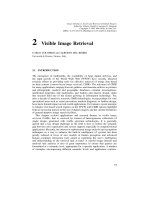Cẩm nang dữ liệu không dây P2 ppsx
Bạn đang xem bản rút gọn của tài liệu. Xem và tải ngay bản đầy đủ của tài liệu tại đây (116.23 KB, 9 trang )
11
2
DATA NETWORK TYPES
2.1 A ROUGH SORT OF TWO-WAY SYSTEMS
In North America terrestrial, two-way wireless data networks can initially be sorted
into private versus public systems. Private system examples include a few very large
users, such as Federal Express, and many smaller systems for public safety (police and
fire departments), taxi/limo dispatch, and utilities. In private systems the infrastructure
is owned, and the spectrum is licensed, by the user. Public systems are for hire. The
end user does not own the infrastructure and has no special rights to the spectrum that
carries the traffic.
2.2 PRIVATE SYSTEMS
2.2.1 Overview
Private systems are often marked by geographic constraints: a metropolitan area or,
smaller still, a railroad yard. Even Federal Express is organized on a city basis;
package delivery vehicles do not drive from New York to Boston (though some 18
wheelers do). Often, private systems have protected frequencies allocated by the
Federal Communications Commission (FCC) for particular industry areas. Coverage
requirements are frequently street level: relatively few base stations aimed at
vehicular targets. Thus, private systems tend to be the provenance of public safety,
utility, and taxi/limo dispatch applications.
No new, very large private systems are being started. The constrained availability
of spectrum in major metropolitan areas virtually precludes the creation of the new
The Wireless Data Handbook, Fourth Edition. James F. DeRose
Copyright © 1999 John Wiley & Sons, Inc.
ISBNs: 0-471-31651-2 (Hardback); 0-471-22458-8 (Electronic)
1000 user-per-city systems like those IBM initiated in 1981. Indeed, IBMs private
system has now been absorbed into ARDIS.
In 1989, after 18 months testing, GE Consumer Services selected Kustom
Electronics to build its nationwide mobile data network.
1
A year later Kustom began
the layoffs
2
that presaged its precipitous decline. In May 1991, with 60 zones
operating, GE announced that it would integrate its existing dispatching
operations with RAM Mobile Data (now BSWD) . . . to expand its coverage areas
and relieve spectrum congestion in some of its cities.
3
GE would also allow
other corporations to use the GE network. That did not happen. Instead, by
mid-1995 GE Appliance had approximately 1600 service personnel on BSWD
4
using quite normal devices.
In 1982 Federal Express began installing a nationwide, mostly data, system using
airtime protocols and devices developed by Mobile Data International (MDI). In 1992
the FedEx waiver request for exclusive use of a single nationwide channel
5
engendered fierce resistance from the Industrial Telecommunications Association. In
1993 Federal Express began to explore public alternatives with a pilot test of 15
vehicles on CDPD.
AT&T Wireless (then McCaw) prematurely announced that Federal Express
plans to begin using McCaws (AirData CDPD system) to augment its existing
private 800 MHz . . . network by early fall (1994) in Las Vegas.
6
This was not totally
surprising given that James Barksdale, once a strong advocate of data radio at Federal
Express, had joined McCaw in 1993. But CDPD schedules slipped alarmingly, there
was no voice backup capability, and Mr. Barksdale went on to more interesting
activities at Netscape. At the close of 1998 Federal Express is roughly one-quarter of
the way through the rollout of their new private system, built by M/A-COM. In 1999
it is entirely possible that FedEx will have more devices installed than all CDPD
carriers combined.
One early vendor motivation for erecting public data systems was that customers
would grow up and graduate to the vendors private infrastructure. There is no
known example of such an event. Indeed, as early as 1992 private networks such as
PSE&G of New Jersey began testing BSWD
7
and later switched to CDPD.
8
Several
other utility companies, including Boston Edison, Florida Power and Light, Illinois
Power, Jacksonville Electric, Pacific Gas & Electric, Southwest Gas, and Washington
Natural Gas are known BSWD users. Motorola sold more than 400 of its private
DataTAC systems in the United States. Now, rather than upgrade to the new
high-bit-rate technology, some are converting to ARDIS, which uses Motorola
infrastructure.
Spectrum considerations aside, the economics favoring public systems are
compelling. Consider a metropolitan area requiring 16 base stations to provide the
desired coverage. Assume that the one-time cost for a private network is $1.75 million,
based on the data in Table 2-1. For simplicity, assume that all one-time costs can be
capitalized and written off over a 10-year period at an interest rate of 10%. Then the
prorated monthly costs of the private system, ignoring inflation, can be estimated as
indicated in Table 2-2.
12
DATA NETWORK TYPES
It is reasonable to add contingency to this calculation. The private versus public
break-even curve shown in Figure 2-1 has both the base curve and a 20% uplifted
version graphed as a function of the number of subscribers. A representative price
curve is also plotted (dashed line) to show public network competitiveness. Average
subscriber revenues from most public carriers have been driven into the range of
$50$55 per month. While there may be traffic dependencies, that price level is
certainly reached in volume bids. In this example the public price declines with
volume to the $550-per-month level.
For a private system of this size to compete on price grounds the customer must
have on the order of 1000 subscribers in a somewhat constrained geographic area. This
Table 2-1 One-time cost: Private network
Cost ($)
Quantity Unit Total
Hardware
Concentrator/switch 2 40,000 80,000
Software licenses 2 40,000 80,000
A/B switch 1 10,000 10,000
Modem rack and 16 modems 1 20,000 20,000
Base stations including modems 16 60,000
960,000
Subtotal 1,150,000
All installation and staging
600,000
Total, with installation 1,750,000
Table 2-2 Prorated monthly cost: Private system
Cost ($) Prorated
Monthly Cost
($)
Item Quantity Monthly Annual 10-Year Total
One-time costs 1,750,000
120 months at 10% 23,126
Recurring costs
Hardware maintenance
a
13,000 130,000 1,083
Leased lines 16 500 96,000 960,000 8,000
Rooftop rentals 16 400 76,800 768,000 6,400
Operations
b
255,000 2,550,000 21,250
59,859
a
10% of purchase price.
b
Three additional monitoring staff at $75,000 per year on 6
×
6 schedule.
2.2 PRIVATE SYSTEMS
13
is very rare. IBMs Field Service force was about 900 in Chicago in 1984, an
exceptional case. If todays customer has only, say, 250 subscribers, the private
system would cost twice as much as going public.
Naturally there are other reasons for choosing a private system, tight control being
the most obvious. Iowa Electric did a major pilot test on ARDIS but, in the end, chose
to go private with a 60-base-station DataTAC system. And more than one utility
company harbors visions of having it both ways. The Southern Company has installed
a Motorola integrated dispatch enhanced network (iDEN) system. This mostly voice
network permits data speeds up to 4800 bps. Southern intends to sell excess capacity
on their network through a subsidiary called Southern Communication Services, with
functions much like Nextel (covered in Chapter 5).
However, as public networks become ubiquitous, there will be a tendency for users
to convert away from their private systems. Even in the public service bastion the
trend toward public systems has begun: the New York Citys Sheriffs Department
switched to ARDIS for parking enforcement,
9
as has Philadelphia.
10
Four of BSWDs
earliest test customers were the Hoboken Fire Department, the Orange County (FL)
Sheriffs Department,
11
the Washington, DC, Police, and the Overland Park, Kansas,
fire departments.
12
While these customers may not be earth shakingsome not even successfulit
is an indication that public safety installations can be breached by public systems.
CDPD specifically targeted Public Safety for its service. AT&T Wireless is known to
have 6 police/sheriffs departments, with Jacksonville, Florida, having 150 units
installed.
13
Bell Atlantic Mobile (BAM) has 10 police installations, including a
14-unit pilot in Washington, DC, that was first tried with BSWD. BAMs largest
police installation is in Philadelphia, with 600 units.
14
GTE Mobilecomm is known to
have at least four police departments, the largest in Lakeland, Florida, with 140
Figure 2-1
Private vs. public break-even point: 16 base stations.
14
DATA NETWORK TYPES
units.
15
Even little Southern New England Telephone (SNET) has 39 small
Connecticut police departments on-line, with an aggregate total of 600 units.
16
2.2.2 Estimating Private Users
In the 1980s there were many suppliers of private systems: for example, Coded
Communications, Electrocom Automation, Gandalf, Kustom, MDI, and Motorola.
Prospects were bright. Federal Express and IBM were thought to be the first in a long
string of major companies to install custom radio data terminals. But eventually
Federal Express was fully deployed, IBM switched to a public system, and the taxi
market, for example, proved to be low margin and exceedingly difficult to penetrate.
In the latter case, New York City Medallion cabs are prohibited by law from being
radio dispatched. By 1989 many of the early contenders had failed.
Motorola bought MDI and consolidated its position in fertile areas such as the
utilities industry. The Canadian vendor Dataradio branched out of fixed equipment
sales in 1987. By 1997 it claimed a 60 percent market share (of devices) . . . for
private networks sold since 1988.
17
In May 1998 it claimed to have over 120,000
(fixed and mobile) units in service in more than 30 countries.
18
Clearly, device
shipments had turned sharply upward again in 1991. To the delight of the few
surviving hardware providers, a significant number of new units shipped were
replacement devices for systems first built 10 years before.
Figure 2-2 portrays this phenomenon. There are two important characteristics of
this chart. First, IBM has been completely removed from all counts. The 1990 switch
from private to public thus does not appear as a sudden decline in private users.
Second, the installed base represents operational units; all spare stocking has been
eliminated.
From the hardware vendors viewpoint, it is quite clear that private systems are
preferable, although their contribution to absolute subscriber growth is not
eye-popping. There were about 125,000 operational users on all terrestrial, two-way
Figure 2-2
U.S. private systems installed base: two-way data.
2.2 PRIVATE SYSTEMS
15
data systems in 1997. Progress in 1998 is expected to be good for Motorola, in
particular, which has carefully protected its
private
DataTAC engineering base. There
are also significant, ongoing shipments to Federal Express by M/A-COM that are
mostly new technology replacement units. The net new users of private systems will
not be greatly enhanced by this upgrade.
2.3 PUBLIC SYSTEMS
If one concentrates on public systems, important differences exist between satellite
and terrestrial offerings. Within public terrestrial, the distinction between circuit
switched and packet switched solutions must be understood.
2.3.1 Satellite Systems
Commercial, two-way data transmission between mobile terminals and satellites
began in 1988. While there have been costly failures in the intervening decade, at the
close of 1998 there was one outstanding success, Qualcomms OmniTRACS. There
were also several contenders, including AMSC and Norcom. The coming of low
earth-orbiting satellites (LEOS), covered in Chapter 6, is certain to raise the level of
activity in this area.
Current satellite systems are distinguished by their unique coverage capability,
which embraces all of the nonmetropolitan areas of the United States. In large
metropolitan areas, building shadows cloak the radio energy. This is exactly where
terrestrial systems perform best and hybrid satellite/terrestrial systems exist that can
provide nearly continuous coverage.
Mobile devices used with satellite systems are typically physically large; their
antenna requirements compel it. This unpleasant characteristic should change with
LEOS. Satellite devices are usually more expensive than the legion of terrestrial
alternatives.
Communication characteristics are often mediocre. These traits range from very
slow bit rates (OmniTRACS) to long latency caused by polling (AMSC).
OmniTRACS time shares a relatively slow speed link among many terminals.
Depending upon received signal strength, each device sees a bit rate of only 55165
bps. Not unexpectedly with such low bit rates, message lengths are limited to a
maximum of 1900 characters, which can take nearly 5 minutes to send.
AMSCs bit rates are far higher, suitable for both voice and facsimile transmission.
However, in data mode latency problems occur because the satellite polls each mobile
terminal one after the other. When a poll reaches a ready terminal, it transmits all
messages it has accumulated. If there are many ready terminals, the poll cycle, the time
required to check every device and return to the top of the list, can easily become 5
minutes.
Satellite airtime costs are typically very much higher than terrestrial counterparts.
In hybrid systems this becomes one more motivating factor to escape the satellite link
as soon as a terrestrial system can be heard.
16
DATA NETWORK TYPES
2.3.1.1 One-Way Paging
A special form of satellite data transmission is
ubiquitous in the United States: one-way paging. Free of the need to respond, the
paging device shrinks to its customary small size. Pager prices are somewhat higher
but still inexpensivetypically
∼
$200. Permissible message lengths are short, rarely
exceeding 240 characters. Monthly charges vary according to the areas of coverage
(which can be international) sought by the user.
In these networks the person initiating the page usually does so by sending the
message from a phone or modem-equipped computer. The message travels to a
paging
terminal
, actually a ground station with an attached satellite dish. The ground station
sends the message, along with the identification number of the receiving pager, to a
satellite. The satellite can broadcast the message and pager ID to one or all of the
terrestrial paging transmitters in the country. Each of these sites rebroadcasts the
message in their particular service area. Every pager in the area hears all messages but
only responds to one with its identification number.
2.3.2 Terrestrial Systems
Terrestrial public systems can be further subdivided into circuit switched [e.g., data
over Advanced Mobile Phone System (AMPS) cellular, Groupe Speciale Mobile
(GSM)] and packet switched (e.g., ARDIS, BSWD, CDPD, and Ricochet). They
differ principally in how they allocate transmission bandwidth. Circuit switched
systems use preallocation of bandwidth; packet switched systems are dynamic.
Telephone networks are circuit switched systems in which a fixed bandwidth is
preallocated for the duration of the call, whether it is voice, data, or image facsimile.
Todays voice cellular systems fall into this category. When the user dials a number,
the virtual path from, say, device to host computer is dedicated to that call (never mind
that the underlying channels may be switching around because of load or user motion).
There is no sharing of that path with any other user.
In dynamic, or packet switched, systems, multiple users may share at least parts of
the same path to get at their own devices/hosts. Historically, the telegraph dynamically
allocated bandwidth one link at a time, never attempting to schedule the whole
source-to-destination path. Obviously this service was limited to non-real-time
systems. The advent of the computer permitted dynamic allocation techniques to be
reexamined for new communication alternatives. Packet switching was the result.
Packet switching was not really an invention, but rather a highly intelligent
reapplication of basic dynamic allocation techniques to data transmission. A packet
switched network only allocates bandwidth when a block of data is ready to be sent;
sophisticated networks only assign enough bandwidth for one block to travel over one
network link at a time.
Depending upon message length, packet switching can be many times more
efficient than circuit switching in reducing bandwidth wastage. But packet switching
carries relatively high unit overhead; it certainly requires both processing power and
buffer storage resources at every node in the network, including the subscriber unit.
The economic trade-off is easy to state but hard to calculate:
2.3 PUBLIC SYSTEMS
17
1. If lines (including cellular) are cheap, use circuit switching.
2. If computing (includes devices) is cheap, use packet switching.
It is not surprising that Europe led the way in packet switching because of its
historically punitive communication tariffs. The continuous decline in the cost of
computing clearly reinforced the drive toward packet switching. The comparison is
less clear in the United States. Useful measurement of these competing costs is the
subject of Chapter 4.
2.3.2.1 Packet Confusion
One fact that often confuses new users is that
packetssegments of messagesare not constrained to packet switching systems.
Forty years ago the messages carried by the SAGE system were segmented to provide
better system control. In the six-year-period 19581964 IBM developed the SABRE
system for American Airlines, drawing on SAGE knowledge. The message
segmentation functions began to be more cleanly defined. The first system/360
teleprocessing system embraced many of these conventions with its basic
telecommunications access method (BTAM), but the simple challenge of
reconfiguring a line or terminal demonstrated how much work remained.
Gradually structure emerged. Each message segment had a header containing basic
information that marked at least:
1. The beginning of the message segment.
2. Address (often both source and destination).
3. Sequence number.
In addition, a trailer held an error detection code and marked the end of the message
segment. By the time the United Kingdoms Donald Davies coined the term
packet
in
1965, a recognizable header, data, trailer structure had been moving across leased,
then circuit switched, facilities for roughly 10 years. Packets still flow on circuit
switched connections. Their structure often has vendor-proprietary wrinkles to
distinguish them from public domain alternatives. But even the flag and the error
detection process used in Microcoms networking protocol (MNP) series is identical
to that of the common packet switched networks. A formal message structure designed
for packet switching can be quite at home on circuit switched alternatives. This is what
dial back-up is all about.
2.4 SUMMARY
The initial classification of systems is into private versus public categories. Until the
1986 advent of Motorolas DRN, all systems were private. If better than street-level
coverage were required, private systems could be built by only the largest customers.
Even without that financial barrier, the scarcity of spectrum created a finite cap on the
number of strictly private systems that could be built.
18
DATA NETWORK TYPES
Public systems are slowly supplanting private ones, even in traditional applications
such as public safety. The user entry-level quantity can be very low, coverage is
generally superior, and professional management of the wireless network leads to
highly satisfactory availability. Public systems may be either satellite or terrestrial.
Satellite is clearly superior when wide coverage is required, but it is burdened by large,
vehicular devices, low communication performance, and high airtime costs.
Terrestrial systems are growing at a far faster rate than satellite. Devices are small,
including two-way pagers that are unfeasible with satellite. Communication
performance is good, and monthly airtime costs are plummeting.
Terrestrial systems can take two basic forms: circuit switched or packet switched.
They are surprisingly competitive and it is not yet clear if one form will dominate
future business activity.
REFERENCES
1.
Mobile Data Report
, 1-15-90.
2.
Mobile Data Report
, 1-14-91.
3.
Mobile Data Report
, 5-6-91.
4. GE Appliances presentation, RAM Mobile Data Analyst and Media Conference, Newark
Radisson, October 31, 1995.
5.
Land Mobile Radio News
, 11-20-92.
6.
PCIA Bulletin
, 7-8-94.
7.
En Route Technology
, 7-8-92.
8. Bell Atlantic Nynex Mobile,
Wireless Data News
, 10-18-95.
9.
On the Air
, Vol. 3, Spring 1993, p. 5.
10.
On the Air
, Vol. 2, Winter 1993, p. 4.
11.
Mobile Data Report
, 9-9-91.
12.
En Route Technology
, 9-26-94.
13.
Wireless Week
, 6-1-98.
14.
Communications Today
, 7-27-97.
15.
Wireless Data News
, 9-18-96.
16.
Wireless Data News
, 10-4-95.
17. Dataradio press release, Johnson Data Telemetry, Jan. 1997.
18. Dataradio press release, Encom Teams Up, 5-27-98.
REFERENCES
19









